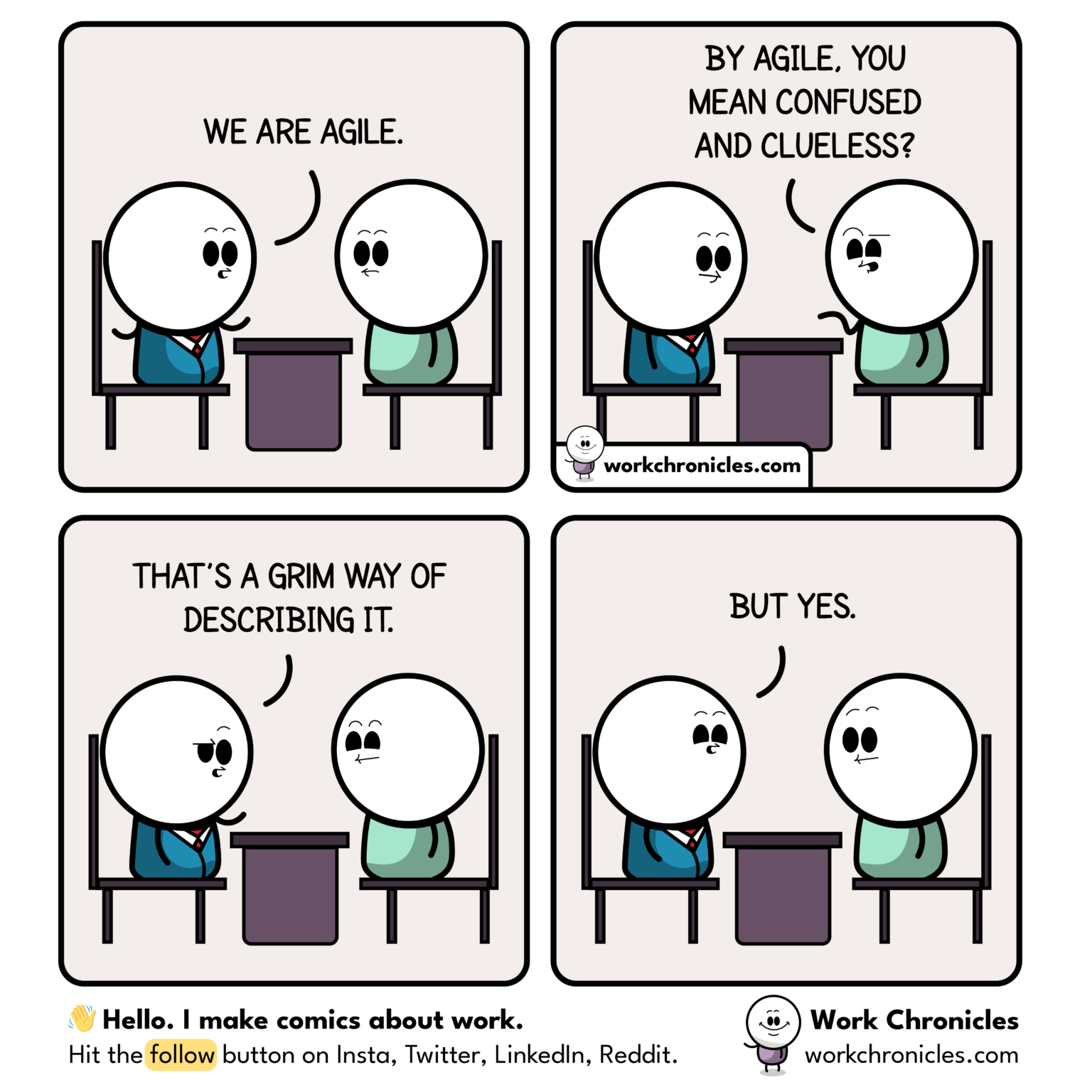Enterprise 'Agile' is just Waterfall with more meetings
May 2, 2025
Let's be honest: most corporate software development isn't agile — it's waterfall in disguise. It's a slow, bloated system wrapped in daily standups and Jira boards.
If you didn't know better, you'd think some bureaucrat designed the entire thing to:
- Keep middle managers busy with process oversight
- Create endless paper trails (docs, tickets, checklists, reviews)
- Delay actual delivery until everyone forgets what the original idea was
The Enterprise Agile Charade
Here's how it really plays out:
- Requirements gathering → months of meetings before anyone writes code
- Design reviews → endless debates over things that will change the second users touch it
- "Sprint planning" → but you can't actually iterate because the scope is locked in
- Redundant meetings → status, grooming, planning, retro, sync, sync about sync
- Artifacts for artifacts' sake → roadmaps, slide decks, Gantt charts, 40-page PRDs no one reads
The worst part? Value delivery doesn't happen iteratively. It happens later — if at all. You don't get tight feedback loops. You don't ship and learn. You just keep feeding the process machine.
The Leadership Doublespeak
The most frustrating part? Leadership that demands contradictory things:
"We're an agile organization!" they proclaim in all-hands meetings, right before asking:
- "When will this feature be done? I promised the director Q3."
- "I need to see the full roadmap for the next 12 months."
- "What's the exact scope of the next four releases?"
- "Why can't you commit to these deadlines?"
They want the perception of being innovative while demanding the certainty of waterfall. They ask for experimentation but punish teams when experiments fail. They request transparency but react poorly to honest timelines.
It's like a restaurant owner demanding farm-to-table quality while insisting on fast-food prices and speed. You can't have it both ways, and pretending otherwise just burns out your team.
When Points Matter More Than Value
When I was a PM, my engineering team was measured on the number of story points completed each sprint. Guess what happened? They started gaming the system.
Tasks that should have been 3 points suddenly became 8. Work that could be finished in a day was stretched to fill a week. Simple bug fixes became "complex refactors." The metrics looked great on executive dashboards, but actual user value crawled to a halt.
This is the inevitable result when you prioritize velocity over value, output over outcomes. Teams optimize for whatever they're measured on — and if that's story points, you'll get more story points, not more customer value.
I've seen teams deliver 100% of their committed points while delivering 0% of what users actually needed. That's not agile; it's statistical theater.
The Agile Industrial Complex
Let's talk money. The amount of cash companies burn on "agile transformation" is staggering:
- $2,000+ for a two-day certification that teaches you how to fill out Jira tickets
- $300,000+ for enterprise agile coaches who build complicated Confluence pages no one reads
- Millions on tools that generate reports proving how "agile" you are
- Countless hours of developer time spent in ceremonies rather than building
It's a massive industry selling the illusion of agility. These consultants show up with their frameworks, certificates, and buzzwords, promising to transform your dinosaur organization into a nimble startup.
Three years and several million dollars later, you still can't ship features in less than six months, but now you have fancy burndown charts documenting your inefficiency.
The Talent Drain
The hidden cost? You're bleeding your best people.
Top engineers, designers, and product managers don't want to work in process-heavy environments where their autonomy is limited and their impact is measured in story points rather than user outcomes.
I've watched brilliant builders leave for smaller companies where they can actually build. I've seen veteran teams reduced to ticket-takers, their creativity and problem-solving skills wasted on implementation details of already-decided solutions.
The people who stay are often those who thrive in bureaucracy — who excel at working the system rather than solving real problems. Your organization slowly transforms into one that values compliance over creativity, estimation accuracy over actual innovation.
And you wonder why you can't compete with the startups eating your lunch.
Real Agile: What It Actually Looks Like
Real agile looks like this:
- Start with a bet and a user problem
- Build just enough to learn
- Ship fast, talk to real people, adapt
- Kill bad ideas quickly
- Empower small teams to own problems, not just tasks
Corporate agile doesn't want this. It wants control. It wants predictability over discovery. It wants project management theater.
Breaking Free
The irony is that predictability in software is largely an illusion. The more you try to control it, the more it slips away.
What actually works:
- Small, empowered teams - Give them problems, not tasks
- Minimal viable process - Just enough structure to stay coordinated
- Rapid shipping cycles - Get real feedback from real users fast
- Outcome focus - Measure results, not output or velocity
- Psychological safety - Make it safe to experiment and occasionally fail
The Path Forward
If you're stuck in enterprise "agile," you have options:
- Work bottom-up - Small teams can often fly under the radar with leaner processes
- Focus on outcomes - Push back on process that doesn't connect to user value
- Build allies - Find the other pragmatists who care more about shipping than ceremonies
- Show, don't tell - Demonstrate results with smaller, faster cycles
But if you're optimizing for learning and outcomes? You've got to break free from the waterfall cargo cult and start building like your users actually matter.
Because at the end of the day, no user ever said: "Wow, I love how many tickets you completed this sprint!"
 Source: Work Chronicles - We are agile
Source: Work Chronicles - We are agile